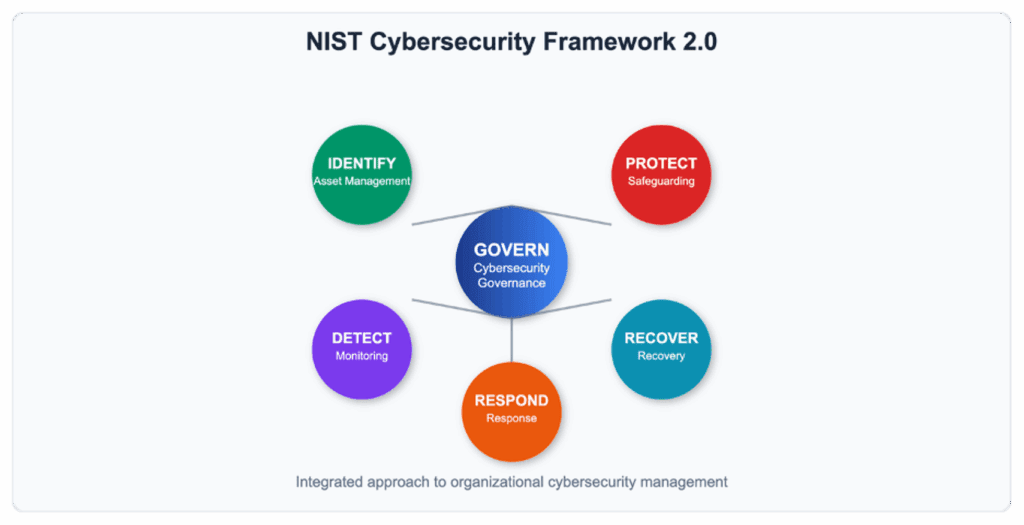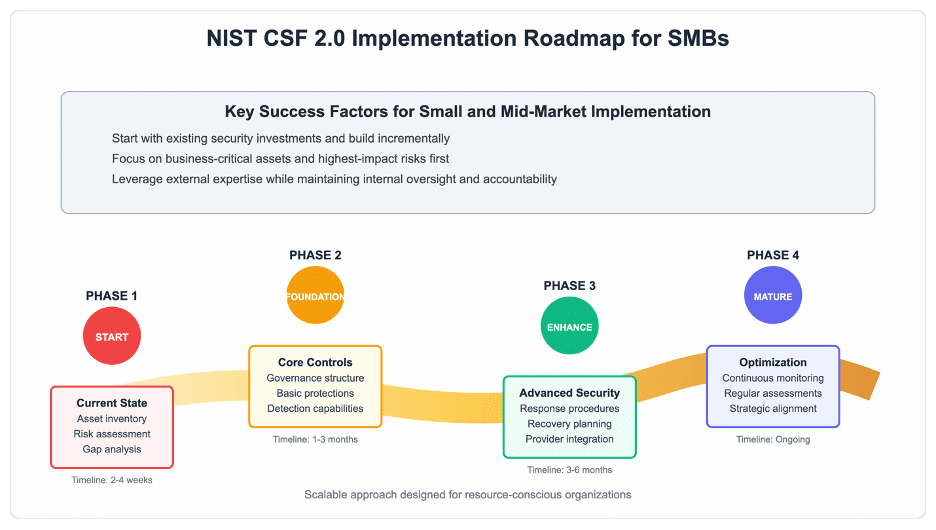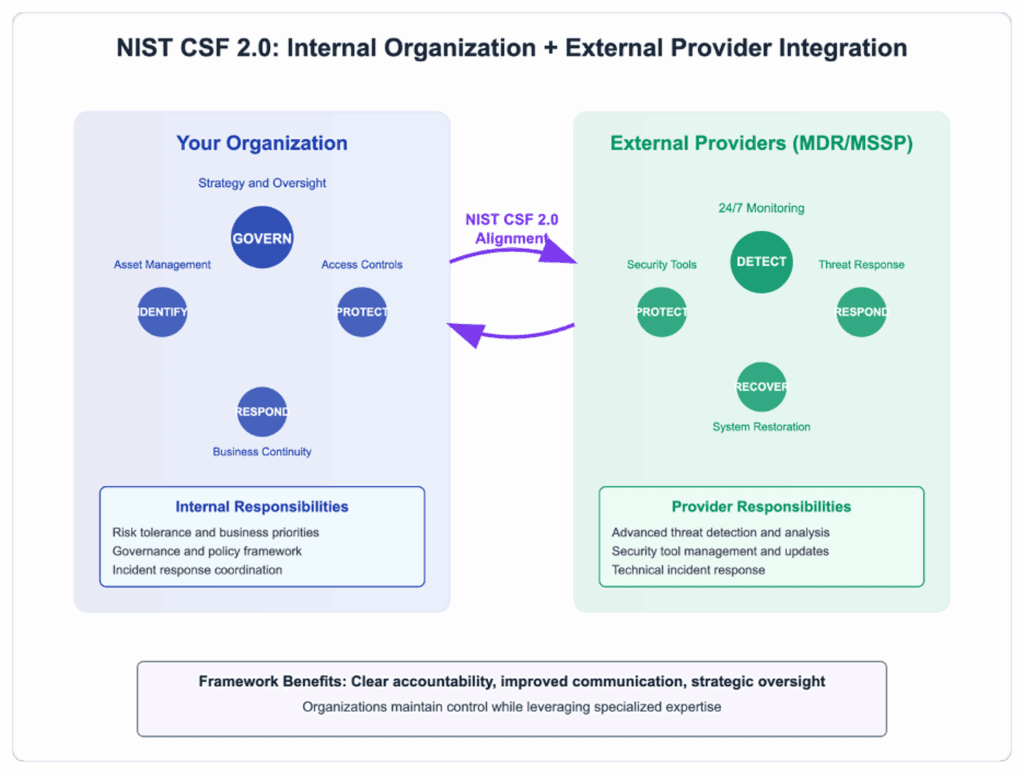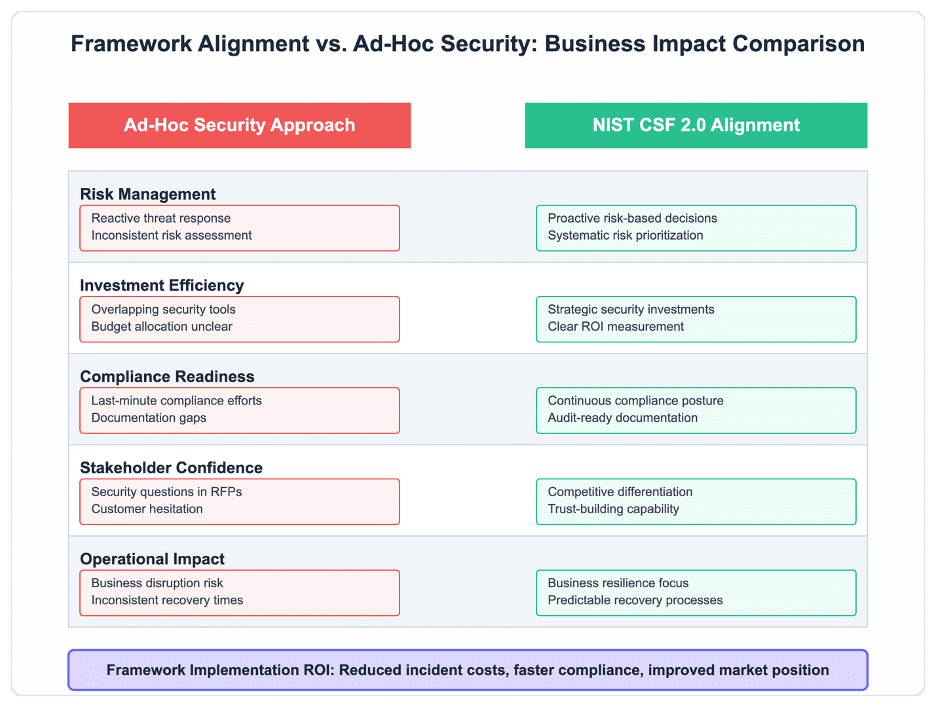Why NIST CSF 2.0 Makes Sense for Mid-Market and Growing Businesses

Written by Brett Arion, Principal, Delivery Quality at Binary Defense
Cybersecurity threats aren’t just a problem for large enterprises. Increasingly, small and mid-sized businesses are being targeted, and often with fewer resources to respond. Many growing organizations are navigating complex client expectations, expanding attack surfaces, and evolving compliance requirements. For these businesses, building a scalable, cost-effective cybersecurity program isn’t optional – it’s essential.
But where do you start?
For organizations with limited internal security teams, the idea of implementing a formal cybersecurity framework can feel out of reach. The NIST Cybersecurity Framework 2.0 (NIST CSF 2.0) changes that. Designed to scale, this framework offers a clear, flexible, and risk-based approach that helps businesses prioritize the right actions without requiring a massive investment in tools or staff.
The Problem: More Risk, Limited Bandwidth
Small and mid-market organizations today face enterprise-level threats without enterprise-sized teams. As digital operations expand, so do the opportunities for attackers. Meanwhile, customer demands, third-party requirements, and industry regulations are raising the bar on cybersecurity expectations.
Yet many growing businesses feel stuck between two extremes:
- Too complex: Cybersecurity frameworks sound daunting, like they are designed for large enterprises with dedicated compliance teams.
- Too reactive: Without a roadmap, security becomes a series of disconnected fixes or vendor tools that lack cohesion.
This is where NIST CSF 2.0 proves its value by bringing structure without overcomplicating, and flexibility without sacrificing rigor.
What Is NIST CSF 2.0 and Why It’s Built for You
The NIST Cybersecurity Framework was originally released in 2014 and has since become one of the most widely recognized security frameworks in the world. The 2024 update (NIST CSF 2.0) makes it even more relevant for businesses like yours.
At its core, NIST CSF 2.0 is designed to help organizations:
- Understand their current cybersecurity posture
- Prioritize improvements based on risk
- Align cybersecurity with business goals
It organizes security efforts into six functional areas:
- Govern
- Identify
- Protect
- Detect
- Respond
- Recover

Each function provides clear, outcome-focused guidance, so leaders and IT teams can focus on what matters most: reducing risk, protecting assets, and supporting business continuity.
Why This Framework Makes Sense for Mid-Market and Growing Businesses
1. It’s Scalable to Your Size
Unlike rigid compliance standards, NIST CSF 2.0 doesn’t require a full security department to implement. It encourages a “start where you are” approach, allowing you to build from what you already have.
Many mid-sized organizations discover they’re already doing parts of the framework; NIST CSF 2.0 simply helps connect those efforts into a cohesive strategy.
2. It Helps You Prioritize Wisely
Limited budget? Limited time? You’re not alone. NIST CSF 2.0 helps you identify the most important risks and focus on what delivers the greatest impact first. It’s a framework built around business value, not just checklists.
3. It Supports Growth and Compliance
Whether you’re working with enterprise clients, preparing for audits, or expanding into regulated markets, framework alignment sends a clear message: your business takes cybersecurity seriously. It also puts you in a better position to meet future compliance requirements without starting from scratch.
4. It’s a Common Language for Providers and Leadership
NIST CSF 2.0 creates a bridge between technical teams, executive leadership, and external security partners. It enables consistent conversations about priorities, investments, and outcomes, no matter your technical background.
Where to Start: A Practical Roadmap
If you’re not using a formal framework today, implementing NIST CSF 2.0 may seem like a big leap. But it doesn’t have to be. Here’s a straightforward way to begin:
Step 1: Assess Your Current State
- Take stock of what you’re already doing across the six NIST CSF functions.
- Identify strengths, gaps, and quick wins.
Step 2: Focus on What Matters Most
- Use the framework’s risk-based guidance to identify which assets, systems, or processes need the most protection.
- Prioritize high-impact actions that align with business risk.
Step 3: Leverage Existing Tools and Services
- NIST CSF 2.0 doesn’t require new software or a full technology overhaul.
- Most businesses can build on their current tools and partnerships, especially MDR providers.
Step 4: Build Toward Continuous Improvement
- Use NIST CSF 2.0 to guide long-term planning.
- Track improvements over time and adapt to new threats as your business evolves

The Role of External Partners
Many growing businesses rely on third-party cybersecurity providers to manage detection, response, and threat intelligence. NIST CSF 2.0 strengthens these relationships by giving you strategic oversight and measurable expectations.
- Set clear goals: Use the framework to define what success looks like.
- Measure outcomes: Track performance across CSF functions.
- Maintain accountability: Ensure service providers align with your risk profile and business objectives.
At Binary Defense, we’ve operationalized NIST CSF 2.0 across our services. Whether we’re providing detection engineering, threat hunting, or strategic advisory, we align with the framework to deliver protection that’s tailored, transparent, and impactful.

Measuring Progress and Demonstrating Value
One of the most valuable aspects of NIST CSF 2.0 is its focus on outcomes, not just activity. This enables organizations to:
- Track measurable improvements in security posture
- Benchmark against peers or industry standards
- Justify cybersecurity investments for boards, executives, and clients.
For many mid-sized businesses, this kind of reporting isn’t just helpful, it’s essential to making informed, strategic decisions about future growth.

A Smarter Starting Point
Cybersecurity frameworks may sound like tools for larger enterprises, but NIST CSF 2.0 is built for everyone, especially growing businesses that need structure without unnecessary complexity.
By aligning your cybersecurity strategy with NIST CSF 2.0, you create a foundation that scales with your business, communicates value to stakeholders, and focuses resources where they matter most.
At Binary Defense, we work with organizations every day who are using NIST CSF 2.0 to take the guesswork out of cybersecurity and replace it with clarity, confidence, and control.
The question isn’t whether you can afford to align with a cybersecurity framework… it’s whether you can afford not to.




